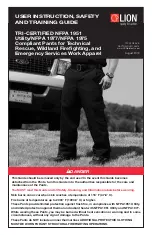
11
8.
PROPER FIT
8.1
CHECKING PROPER FIT
All Pants must have adequate looseness in the torso and legs to ensure that
insulated air spaces are maintained. If the Pants bunch bind in the thighs or crotch
area, it is probably too small. Pants also should not be too loose, as this could
hinder mobility and place stress at the wrong places in the Pants. Upon receiving
new or replacement Pants, make sure that there are at least a few inches of loose
material around the seat and thigh. Then test the mobility by climbing stairs and
crawling or duck walking.
8.2
CHECKING THE SIZE
If the garment does not seem to fit properly, you should check the size in the label to
make sure it is your size as measured, and to make sure it is your Pants.
9.
MARKING CONSIDERATIONS
For marking an individual’s name, or other identifying mark, an indelible laundry marker may
be used. LION recommends marking the Pants in the following manner:
9.1
First, check the Fabric Content Label (it has a serial number on it) to
determine whether adequate identifying information was already printed by the
manufacturer. The underside of the facing at the Pants fly is recommended.
NEVER MARK ON THE SAFETY, CLEANING, OR INFORMATION LABELS ON
YOUR GARMENT!
Never wear Pants that fit improperly. If you have a question, or there is a problem with
the fit of the Pants, contact your safety officer for assistance. Wearing a Pants that does
not fit properly could reduce protection and result in severe burns, cuts, or abrasions, or
dangerously restrict your ability to avoid injuries in an emergency situation.
!
DANGER
7.
DONNING AND DOFFING
7.1
DONNING (PUTTING ON) YOUR GARMENT
With the fly closure unfastened, hold open the
Pants. After pulling the Pants to the waist, fasten the
fly closure securely. See
(FIG. 5)
. Cinch
take-up straps, if present, so the Pants are snug
at your waist. Pants that hang down too low in the
crotch will dangerously restrict your mobility and will
wear out prematurely in the crotch seams. When
properly fitted, and correctly donned, the cuffs
of your Pants should be no less than 2" and not
more than 5" off the floor. Step into your protective
footwear, and if they are adjustable, zip them up or
tie the laces.
7.2
DOFFING (REMOVING) YOUR GARMENT
A.
First, never remove any personal protective clothing or equipment until you are
certain that you are safely removed from the hazard area. Always wear your full
ensemble during all phases of Technical Rescue and/or Wildland operations.
B. When you are ready to remove your Pants, you should first remove your gloves,
helmet, and coat as applicable.
C. Next disengage the fly closure on your Pants and remove them.
FIG. 5
Summary of Contents for NFPA 1975
Page 22: ...22 NOTES...
























